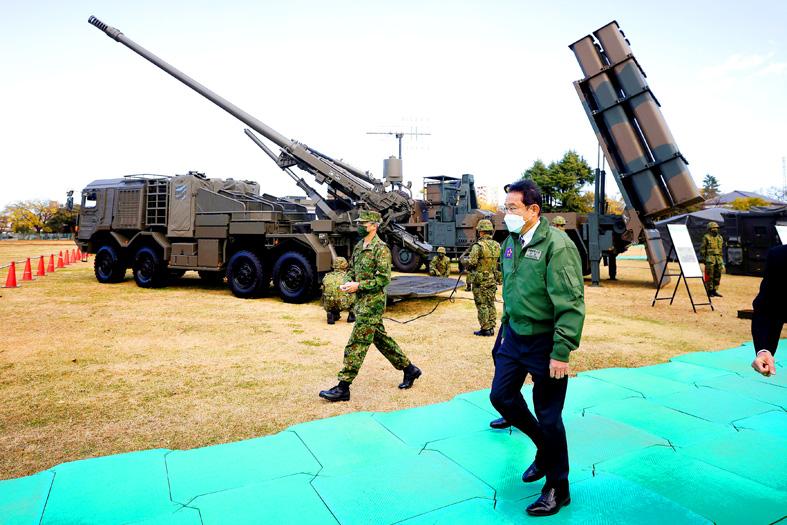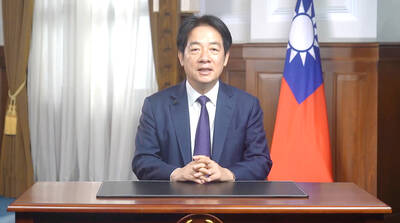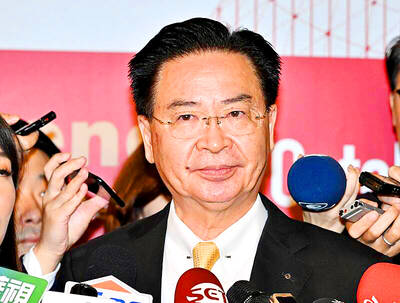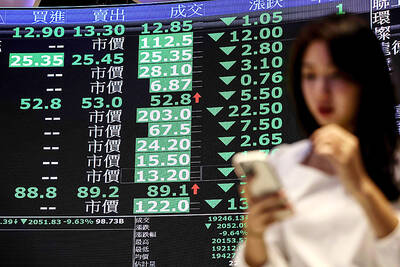Japan is considering the deployment of more than 1,000 long-range cruise missiles to increase its ability to counter growing regional threats from China, the Yomiuri Shimbun reported yesterday.
The country plans to upgrade its existing surface-to-ship missiles to extend their range from 100km to about 1,000km, which would be enough to reach Chinese coastal areas, as well as North Korea, the newspaper reported, citing unnamed sources.
Upgrades would also need to be made to enable Japan’s ships and aircraft to be able to fire the new missiles, which could hit land-based targets, the newspaper reported.

Photo: Reuters
The missiles would be deployed in and around the southwestern Kyushu region and on the small islands that dot Japan’s southwestern waters near Taiwan, the Yomiuri reported.
Japanese officials could not be reached for comment.
The plan is part of Japan’s attempt to narrow its missile capacity gap with China, while also addressing threats from North Korea, the newspaper said.
Japan’s military is not officially recognized under the country’s post-war constitution and defense spending is limited to funding nominally defensive capabilities.
Recent geopolitical tensions, including Russia’s invasion of Ukraine and China’s increasingly aggressive stance toward Taiwan, have prompted growing calls in Japan to review defense programs.
Regional tensions ratcheted up this month after a visit by US House of Representatives Speaker Nancy Pelosi to Taiwan. In response, Beijing launched missiles over Taiwan and into Japan’s exclusive economic zone.
Japanese Prime Minister Fumio Kishida has vowed to significantly boost defense spending, which has been kept near 1 percent of GDP.
Local media also reported that the Japanese Ministry of Defense is likely to request ¥5.5 trillion (US$40.2 billion) for the next fiscal year, up slightly from the ¥5.18 trillion requested for this fiscal year.
However, the ministry was also expected to ask approval for a list of unpriced items, including the development cost to upgrade the long-range cruise missiles, the Asahi Shimbun reported.
Additional reporting by Reuters

ACTION PLAN: Taiwan would expand procurement from the US and encourage more companies to invest in the US to deepen bilateral cooperation, Lai said The government would not impose reciprocal tariffs in retaliation against US levies, President William Lai (賴清德) said yesterday, as he announced five strategies to address the issue, including pledging to increase Taiwanese companies’ investments in the US. Lai has in the past few days met with administrative and national security officials, as well as representatives from various industries, to explore countermeasures after US President Donald Trump on Wednesday last week announced a 32 percent duty on Taiwanese imports. In a video released yesterday evening, Lai said that Taiwan would not retaliate against the US with higher tariffs and Taiwanese companies’ commitments to

Intelligence agents have recorded 510,000 instances of “controversial information” being spread online by the Chinese Communist Party (CCP) so far this year, the National Security Bureau (NSB) said in a report yesterday, as it warned of artificial intelligence (AI) being employed to generate destabilizing misinformation. The bureau submitted a written report to the Legislative Yuan in preparation for National Security Bureau Director-General Tsai Ming-yen’s (蔡明彥) appearance before the Foreign Affairs and National Defense Committee today. The CCP has been using cognitive warfare to divide Taiwanese society by commenting on controversial issues such as Taiwan Semiconductor Manufacturing Co’s (TSMC, 台積電) investments in the

‘SPECIAL CHANNEL’: Taipei’s most important tasks are to stabilize industries affected by Trump’s trade tariffs and keep negotiations with Washington open, a source said National Security Council Secretary-General Joseph Wu (吳釗燮) arrived in the US for talks with US President Donald Trump’s administration, a source familiar with the matter said on Friday. Wu was leading a delegation for a meeting known as the “special channel,” the Financial Times reported earlier. It marked Trump’s first use of the channel since returning to the White House on Jan. 20. Citing a source familiar with the matter, the Financial Times reported that Minister of Foreign Affairs Lin Chia-lung (林佳龍) was also a part of the delegation. The visit came days after China concluded war games around Taiwan and amid Trump’s

HELPING HAND: The steering committee of the National Stabilization Fund is expected to hold a meeting to discuss how and when to utilize the fund to help buffer the sell-off The TAIEX plunged 2,065.87 points, or 9.7 percent, to close at 19,232.35 yesterday, the highest single-day percentage loss on record, as investors braced for US President Donald Trump’s tariffs after an extended holiday weekend. Amid the pessimistic atmosphere, 945 listed companies led by large-cap stocks — including Taiwan Semiconductor Manufacturing Co (TSMC, 台積電), Hon Hai Precision Industry Co (鴻海精密) and Largan Precision Co (大立光) — fell by the daily maximum of 10 percent at the close, Taiwan Stock Exchange data showed. The number of listed companies ending limit-down set a new record, the exchange said. The TAIEX plunged by daily maxiumu in just